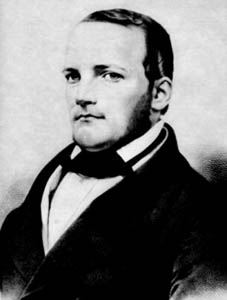
Born:May 5, 1819, Ubiel, Russia (presently Belarus)
Died: June 4, 1872, Warsaw, Russian partition of Poland (presently Poland)
Early Days. Stanisław Moniuszko was born to the patriotic family of Polish landowners settled in Ubiel, near Minsk. His interest in music became evident early in his childhood when he got his initial education with his mother, Elzbieta. In 1827 he was introduced to the rudiments of music by taking private piano lessons with August Freyer in Warsaw to continue with Dominik Stefanowicz in Minsk from 1830.
Studies. Marriage. His formal music education took place in Berlin in 1837 where under Carl Friedrich Rungenhagen he studied composition and choral conducting. Several of his songs composed during this period were published by the firm of Bote & Bock and were favorably received by the music critics. In 1840, after returning from Berlin, he married Aleksandra Miller and settled down in Wilno (presently Vilnius), where he took the organist’s position at St.John’s church. During that time he became acquainted with the novelist Jozef Ignacy Kraszewski and playwright-satirist Aleksander Fredro. These contacts stimulated his interest in dramatic music.
Creative work. He began composing intensively writing his first operas, other stage works, sacred music as well as secular cantatas. At about this time he also commenced work on the collection of songs entitled Spiewnik Domowy (Songbook for Home Use), which would have wide appeal to Polish public. The first volume of this collection was published in 1843 and met with much interest among both the public and music critics. Over the years the collection grew to 12 volumes - 267 songs with piano accompaniment. Although many of the songs are simple, predominately strophic, there are also those which take on a form of dialogues or ballads and majority testify to composer’s originality and melodic inventiveness. The source of Moniuszko's melodies and rhythmic patterns often lies in Polish musical folklore; the majority of the texts is that of prominent Polish poets: Mickiewicz, Pol, Syrokomla, Lenartowicz, Czeczot, Odyniec. During his lifetime Moniuszko traveled several times to St. Petersburg where his concerts were very well received. Serov, the young Russian critic of the time, referred to Moniuszko's compositions as "brilliant works." While in St. Petersburg Moniuszko met and befriended many of his contemporaries, prominent in Russian music, including Mikhail Glinka, MilyBalakirev, and Modest Mussorgsky. To Alexander Dargomyzhsky, with whom he became very close, he dedicated his overture Bajka (Fairytale). In 1858, thanks to the help of the pianist Maria Kalergis, Moniuszko journeyed to Paris, where he me Aubert and Rossini, and Berlin, paid a visit to Bedrich Smetana who prepared in Prague the premiere of Moniuszko’s “Halka”, and to Weimar, where he met with Franz Liszt.
Most crucial to Moniuszko's career was, however, his visit to Warsaw in 1848. He met there Jozef Sikorski, the future editor of the most notable Polish music journal Ruch Muzyczny (Musical Movement), Oscar Kolberg a well-known folk song collector, and Wlodzimierz Wolski a poet and future librettist of Moniuszko's best known opera Halka. Named after its heroine, Halka, after being shown in 1848 in Wilno, was premiered with great success in 1858 in Warsaw and later in Prague, Moscow and St. Petersburg. The engagement of the composer as an opera conductor at the Grand Theatre in Warsaw followed in 1859. From 1964 he also taught harmony and counterpoint at the Musical Institute there. After Halka came other major operatic compositions: Flis (The Raftsman, 1858), Hrabina (The Countess, 1860), Verbum Nobile (1861), and most important Straszny Dwor (The Haunted Manor, 1865).. The common trait shared by all these works are librettos which while depicting Polish nobility and gentry, and sometimes even the characters of common origins, above all, emphasized Polish customs and traditions, and at the time of national strife, sustained and fostered patriotic feelings. The music of Moniuszko's works is largely representative of the 19-th century opera, given the extensive use by the composer of arias, recitatives and ensembles, with the exception of Straszny Dwor (The Haunted Manor), where beautifully scored choral parts testify to Moniuszko's mastery of writing for many voices. His music too, although stylistically distinct, evidently incorporates many national motifs: Polish dances popular among upper classes such as polonaise and mazurka, and folk tunes and dances such as kujawiak and krakowiak. The most notable among his choral works are cantatas Sonety krymskie (Crimean Sonnets) and Widma (Phantoms) composed to the texts of Adam Mickiewicz, the leading poet of the Polish Romanticism. The melodic line of the former is particularly expressive and in parts of the composition takes on the form of variations. Moniuszko lived in Warsaw until his death of a sudden heart attack in 1872. His funeral became a great patriotic demonstration. Moniuszko was buried at the Powazki Cemetery in Warsaw.
This biography created in 1997 by M. Pilatowicz; has been copied with minor changes from the Webpage “Polish Composers” of the Polish Music Center of the University of Southern California, Los Angeles, CA with the permission of Ms. Krysta Close, Center’s Manager.
See:
Polish Music Center
For the list of Stanislaw Moniuszko’s works see the above URL
See also: B. M. Maciejewski's, Moniuszko. Father of Polish Opera (Library of Congress no. ML 410 M752 M3). 1979, London, Allegro Press.
Other sources:
Radoslaw Rzepkowski
Polish Music Information Center
Listen to Moniuszko's music!
Return to home page:
Prominent Poles